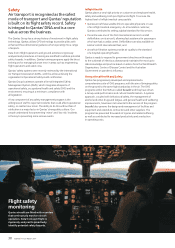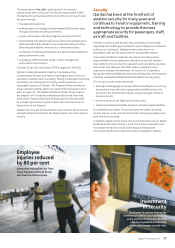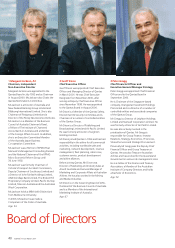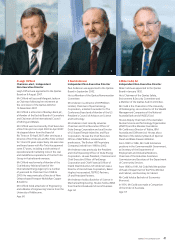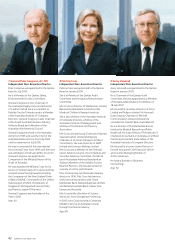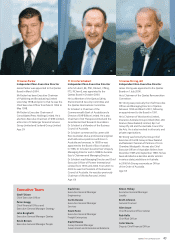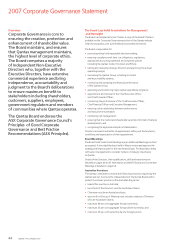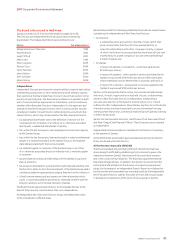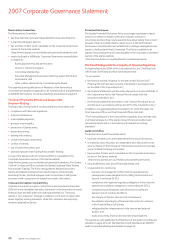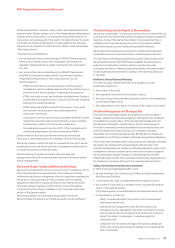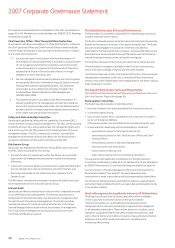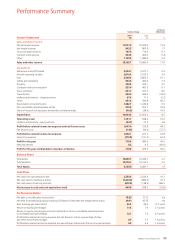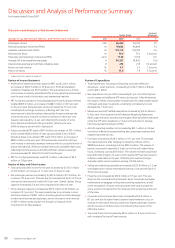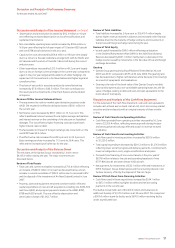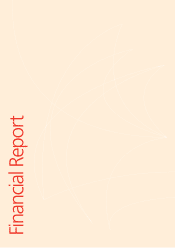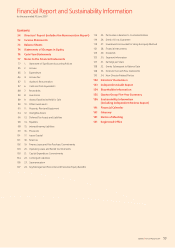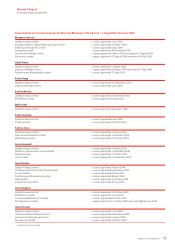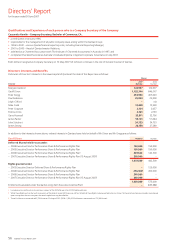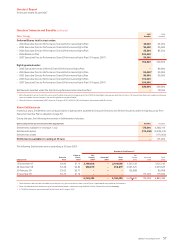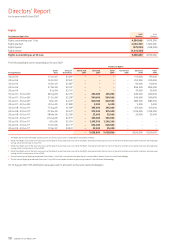Qantas 2007 Annual Report Download - page 50
Download and view the complete annual report
Please find page 50 of the 2007 Qantas annual report below. You can navigate through the pages in the report by either clicking on the pages listed below, or by using the keyword search tool below to find specific information within the annual report.The experience and qualifications of Members of the SESC are detailed on
pages 40 to 43. Membership of and attendance at 2006/07 SESC Meetings
are detailed on page 54.
Chief Executive Officer /Chief Financial Officer Declaration
In accordance with Recommendation 7.2 of the ASX Principles, at the time
the Chief Executive Officer and Chief Financial Officer provide the Board
with the Financial Declaration, they also state to the Board that, in respect
of the entire reporting period:
“1.1 the statement given in accordance with Recommendation 4.1
(the integrity of financial statements) is founded on a sound system
of risk management and internal compliance and control which,
in all material respects, implements the policies which have been
adopted by the Board of Directors either directly or through
delegation to senior executives; and
1.2 the risk management and internal compliance and control systems
are operating effectively, in all material respects, based on the risk
management statement adopted by Qantas. This statement
incorporates as its foundation the principles included in the
Australian/New Zealand Standard on Risk Management
(AS/NZS 4360:2004).
2. The statements given in accordance with Recommendation 7.2
(above) regarding the risk management and internal compliance
and control system provide a reasonable, but not absolute level of
assurance and do not imply a guarantee against adverse events or
more volatile outcomes arising in the future.”
Safety and Risk Leadership Committee
Qantas has established a Safety and Risk Leadership Committee (SRLC),
whose members include Executive Management. The SRLC meets quarterly
to identify all major risks, ensure appropriate risk management plans are in
place and to monitor the effectiveness of the implementation of the risk
management plans. The SRLC prepares a bi-monthly Corporate Risk
Management and Internal Audit Activity Report for the Board which is
reviewed in detail by both the Audit Committee and the SESC.
Risk Review Group
Qantas has also established a Risk Review Group (RRG), which reports to
the SRLC and is responsible for monitoring:
the identification of material risks within the Qantas Group and that
appropriate risk management processes are in place and operating
effectively;
action plans in place to address inconsistencies or gaps identified within
the risk management, internal compliance and control system; and
the review and update of risk infrastructure for relevance to the
Qantas Group.
The RRG meets monthly and its members comprise risk practitioners and
other representatives from across the Qantas Group.
Internal Audit
Qantas has an effective Internal Audit function which is materially involved
in risk identification and management. The Internal Audit function is
independent of the external auditor, has full access to management and
the right to seek information and explanation. The Audit Committee
oversees the scope of the Internal Audit and has access to the Group
General Manager Internal Audit without the presence of management.
The Group General Manager Internal Audit has access to the Audit
Committee and Board as required.
•
•
•
The Board Encourages Enhanced Performance
The Nominations Committee is responsible for implementing a process to
evaluate the Board’s performance.
The Board continually assesses its performance internally and discussed the
Board’s performance on a number of occasions during the year. The Board
also periodically engages the assistance of external consultants to
undertake formal Board performance reviews. A review undertaken by the
Board and an external consultant during 2006 will be used to facilitate an
internal Board performance review during the coming year.
The Chairman discusses performance with each Director during the year.
A formal induction program is available to new Directors to ensure they
have a working knowledge of Qantas and the airline industry.
The Directors have open access to all relevant information, there are regular
management presentations and visits to interstate/offshore operations.
Directors may meet independently with management at any time to discuss
areas of interest or concern.
The Board Remunerates Fairly and Responsibly
The Qantas Executive Remuneration Philosophy and Objectives is set out in
full in the Directors’ Report (from page 59).
Remuneration Committee
The Board has a Remuneration Committee which:
has three members who are Independent Non-Executive Directors;
is chaired by James Strong;
has a written Charter which is available on the Corporate Governance
section of the Qantas Website:
(http://www.qantas.com.au/info/about/corporateGovernance); and
is responsible for developing and recommending to the Board:
remuneration policies for Non-Executive Directors;
remuneration policies for the Chief Executive Officer and Chief
Financial Officer;
remuneration policies for Executive Management;
Executive option and share grants;
human resources policies; and
other matters referred to the Committee by the Board.
The experience and qualifications of Members of the Remuneration
Committee are detailed on pages 40 to 43. Membership of and attendance
at 2006/07 Remuneration Committee Meetings are detailed on page 54.
The remuneration of the Key Management Personnel is disclosed in the
Remuneration Report from page 59. All equity-based Executive
remuneration is made in accordance with plans approved by shareholders.
On retirement, Qantas Directors are entitled to statutory superannuation
and certain travel entitlements which are reasonable and standard practice
in the aviation industry.
Qantas Recognises the Legitimate Interests of Stakeholders
The Board has a formal code of conduct and ethics which is available
on the Corporate Governance section of the Qantas website:
(http://www.qantas.com.au/info/about/corporateGovernance).
Qantas also has formal policies relating to its legal and other obligations
to all legitimate stakeholders. These include areas such as safety, service
standards, occupational health and safety, employment practices, staff
and contractor training, fair trading, consumer privacy and environmental
protection. Each policy includes procedures for compliance and
monitoring effectiveness.
•
•
•
•
–
–
–
–
–
–
48 Qantas |Annual Report 2007
2007 Corporate Governance Statement


